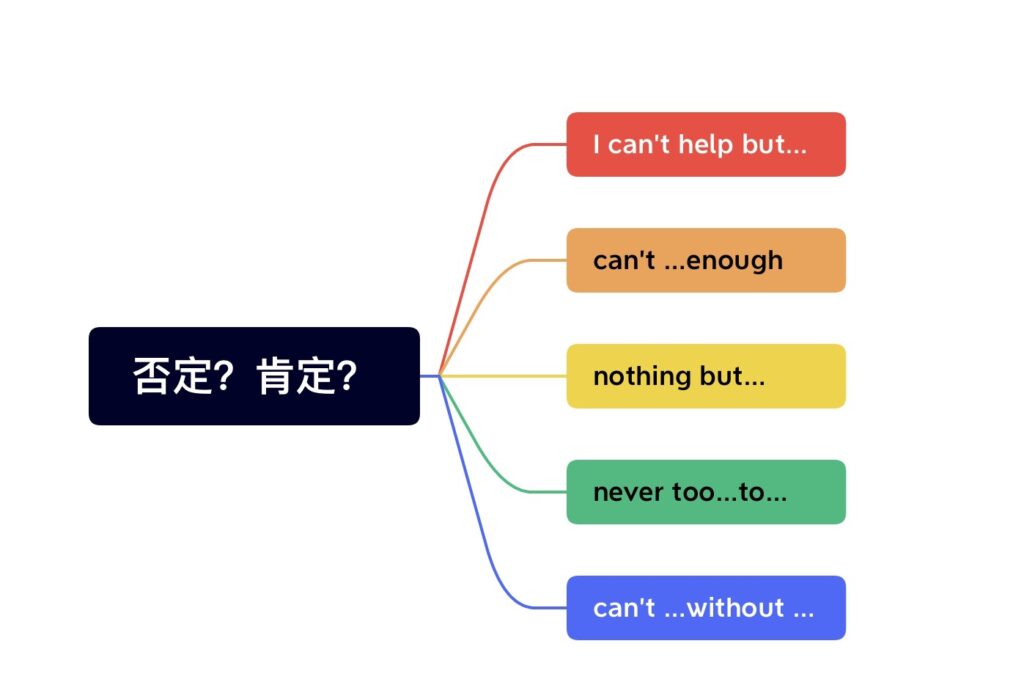看似否定,实则肯定
在英语高中学习中,通常会学到一些否定的句子,句子绕绕绕去,让人琢磨不透句意,以下是一些常见的看似否定,实则肯定的句型。
“I can’t help but”(我忍不住)
例句:I can’t help but admire her talent.(我忍不住对她的才华佩服。)
“There is not a single doubt that”(毫无疑问)
例句:There is not a single doubt that she will succeed.(毫无疑问她会成功。)
“I cannot disagree that”(我不能不同意)
例句:I cannot disagree that the project is well-executed.(我不能不同意这个项目执行得很好。)
“It is impossible not to”(不可能不)
例句:It is impossible not to appreciate his dedication.(不可能不欣赏他的奉献精神。)
“There is no denying that”(不可否认)
例句:There is no denying that she is a talented musician.(不可否认她是一位有才华的音乐家。)
can/could not…too(无论怎样也不过分)
例如:You can never be too careful in performing an experiment.做实验越仔细越好。
can/couldnot….enough(无论怎么都不够,表示强烈的肯定)
例如:I cannot thank you enough. 我对你感激不尽。
nothing but(只有,只不过,含肯定意义)
例如:We couldsee nothingbutwater. 我们只看见一大片水。
never too.….to是对too.…to的再否定,表示肯定。
例如: It is never too late to give up prejudices.放弃偏见永远不晚。
not…without…没有……就没有; 在这个句型中,使用两个否定,用来加强语气,表示肯定意义。
例如:One cannot live even a fewminutes withoutair. 没有空气,人们甚至连几分钟也不能生存
nothing if not表示“极其”,含强烈的肯定意义。
例如:The story was nothing if not interesting故事极其有趣。
nothing less than表示“完全是”,有肯定的含义。
例如:His negligence was nothing less than criminal.他的粗心大意无异于犯罪。
too…not to表示“太……不会不……”,具有肯定意义。
例如:His speech was too good not to stir the audience.他的演讲太好了,不会不使观众轰动。
no的否定意义很强,和具有否定意义的名词连用,来表示强烈的肯定。
例如:There is no question that Mr.Smith is the boss.毫无疑问,史密斯先生就是老板。
not…until/till表示“直到……才”,具有肯定的意义。
双重否定
双重否定表示强烈的肯定。否定+否定=肯定,加强句子的肯定语气,这样的双重否定句被称之为肯定型双重否定句。
1)谓语否定+状语否定
You cannot make eggrolls with out breaking eggs不打破鸡蛋,就无法做出蛋卷来。(即:有失才有得。)
2)主语否定+状语否定
In some countries no major business is carried on without eye contact, requiring face to face conversation在有些国家,一切公事都要面对面地进行,需要当面交谈。
3)主语否定+谓语否定
Nobody does not believe in him人人相信他。
4)谓语否定+宾语否定
We can’t afford not to believe the missile attack我们不得不相信这导弹袭击是真的。
5)主语否定+宾语否定
Nobody has no access to the sporting facilities人人都可以使用这些体育器材。
6)主语否定+补语否定
Nothing is nothing at all. 没有一件事是微不足道的。
7)否定词+否定意义的动词/名词/形容词/副词
There is no denying the fact that your action has affected her normal life不可否认,你的行为已经影响了她的正常生活。
8)主句否定+从句否定
In the neighborhood there is nobody who does not knowme在这儿,我绝对是个名人。
There is no rule but has exceptions任何规则都有例外。
Extra句型
以Why don’t you….和Why not…开头的疑问句往往表示邀请、建议、指导等,具有肯定意义。
例如:Whv not come and see metomorrow?明天来看我怎么样?
nothing(或no+名词)but….只有;仅仅;
Nothingbut=only,表示肯定意义,
例如:No one but him in our class can swim across the river.在我们班上,只有他能游过这条河。
祈使疑问句:否定感叹疑问句表示的肯定表示肯定意义。
例如:Isn’t the film wonderful?多么好的一部影片啊!
hardly/scarcely.…when一(刚)…就…;
例如:Hehad hardlv/scarcely arrived when it began to rain.他一到天就开始下雨了。
no sooner…than.…一(刚)………就……;
例如:No sooner had they got to the theatre than the concertbegan.他们刚跨进剧院,音乐会就开始了。
can+not+be+形容词+enough/cannot+动词原形+toomuch(highly)越……越好;无论怎样也不过分;
例如:Heis a heroWe can not praise him too much(highly)。他是英雄,我们无论怎样赞扬他也不过分。
否定词+比较级(相当于最高级),常见的句型是:have nevert过去分词+比较级,最……;再没有比……更…;该句型从反面表示“最……”的概念。
例如:We have never seen a more interesting film than this one这部电影是我们看过的最有趣的影片。
这些句型使用了否定词,但实际上表达了肯定的意思。在这些句型中,双重否定用法常用于强调某种情感、观点或确信的程度。但同样需要注意,在正式的书面英语中,避免过度使用双重否定,以保持语言的清晰和准确性。
Minamap解析
